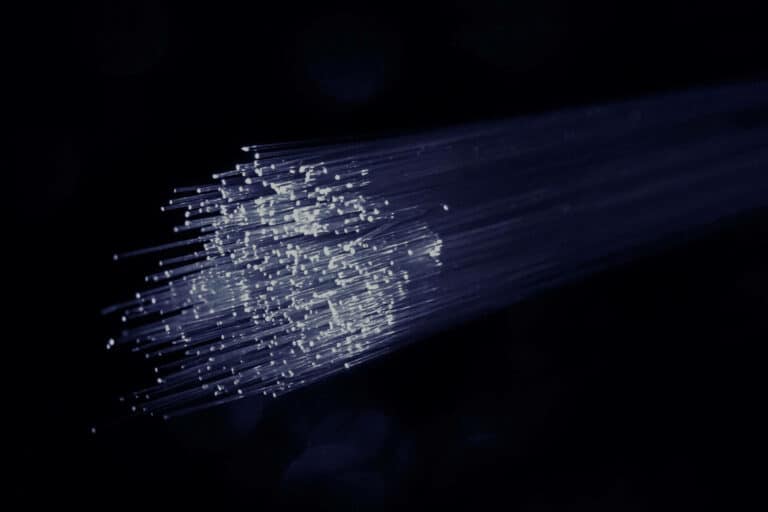
SpaceX’s Starlink: everything you need to know
Elon Musk. The name will ring a bell. Discover his new project!
We’ll take care of your connection
A no nonsense network for every sector
Our knowledge accumulated through years of expertise
A company with a passion for technology and signals
 English
English
Fiber optic internet, commonly referred to as “fiber” or “fiber optic”, is a broadband connection that achieves speeds of more than 940 Megabits per second (Mbps) and has a very low latency (ping).
This relatively new technology uses fiber optic cable, which can achieve unprecedented speeds over a cable. As the word implies, a fiber optic cable is made up of small flexible glass fibre wires. This is necessary to send the signals via light particles through the cable. Light particles? Yes you heard it right. It is thanks to this technology that we can now achieve speeds of up to 70% of the speed of light!
You no longer have to wait an entire evening for your game to download and no more annoying buffer waiting times for your movie. The future is here, and it is brought to you using a fiber optic cable.
In order to answer this, we need to know how the different connection methods operate.
DSL or Digital Subscriber Line is Internet through the telephone line. To put it simply, the existing telephone lines are used to send multiple signals. To this day, Proximus still uses these lines to provide their internet services.
There are two primary types of DSL connections: symmetric and asymmetric. A symmetrical connection will give you equal upload and download speeds, while an asymmetrical connection will give up some upload speeds to increase the download speed
DSL is a continuous, but not always strong stream to your home or business. The “continuous” refers to the fact that there is a direct connection to the nearest local exchange. This means that your internet is not “shared” with any neighbors who are on the same cabling.
The strength of your internet will therefore be influenced by other factors (because, how many people do you know who have a perfect internet connection?). On the one hand, the further the distance from the nearest local exchange, the slower your internet speed will be. On the other hand, your own usage has an impact on your internet speed.
With a DSL cable you get a maximum of bandwidth. Both your internet and television are on this bandwidth. In other words, when people watch TV, it will have an impact on your surfing speeds. Your television then takes up part of the bandwidth that was previously used during surfing. So don’t be fooled when a DSL provider offers interesting formulas with high download speeds! These speeds may be correct for some, but the variables of distance to local exchange and simultaneity of use have not been taken into account.
With the above variables in mind, DSL internet can achieve download speeds from 1 to 400 MBps, while upload speeds range between 384 Kbps and 8Mbps.
Cable internet refers to the coaxial cable used to bring the internet to you. This is the kind of internet that Telenet uses.
The advantages and disadvantages of this internet are the direct opposite to those of the DSL internet. On the one hand, both the distance and the bandwidth have no influence on your surfing speeds. On the other hand, your neighbors do have an impact on your internet speeds. Cable internet operates via a shared network, which can greatly reduce your performance during peak use. Telenet, for example, has various formulas that limit your download speeds during peak hours, in order to monitor the network load.
The download speed of cable varies from 25 Mbps to 1 Gbps (it is never that high in practice, because you are never the only one on a shared network). Upload speeds vary between 5 and 50 Mbps.
Fiber internet gives you speeds of up to 1Gbps, but is not affected by other factors! You are not part of a shared network and the cable distances do not matter. In addition, the cables are very resistant to problems such as moisture in the cable. As a result, you can always enjoy an optimal and stable speed. Say goodbye to video calls that stutter and movies that suddenly start buffering in the middle.
Curious how fast your internet is? Test it yourself on the Ookla website!
Where you live and which provider you are with, are two important criteria to determine whether or not you can enjoy a fiber connection.
Proximus was among the first to develop their own fiber network. Currently they are mainly limited to the big cities, but new areas are added every day. Here you can see whether Proximus is already present outside your home with their fiber optic connection.
Telenet currently does not have a “complete” fiber network. They still opt for the coax cable to the home, but the coaxial part of Telenet to the distribution room is already equipped with Fiber. Telenet currently operates fully with a hybrid fiber optic-coax network. In this way they can provide quite stable download speeds of up to 500 Mbps, but you are still affected by the amount of users branching off from the same distribution station.
In addition to the operators, Fluvius also has an operational fiber optic network in Belgium. Some less well-known operators, but also Orange, are already using this. Orange is still in a trial period and are therefore present in few places. On the Orange website you can see which households can try out their fiber network. Today (22/09/2021) this is only in Genk, Ghent, Diksmuide, Poperinge and Antwerp. You can currently only request a free fiber connection from them in Antwerp.
How much does fiber cost?
Fiber prices can be compared with the prices you currently pay for your internet subscription. You will not have to bear absurdly high costs to be able to enjoy this kind of internet. Please note: as I mentioned above, you may have a one-time cost on top of your subscription for the connection to the fiber network. The connections don’t magically extend into your home ;). At Orange, for example, this can amount to just under 500 euros.
Naturally! There is no other instance that can give you the same stability and strength as Fiber. It’s only a matter of time before fiber becomes the norm and you’ll be stared down at if you’re still surfing over DSL or coaxial cable.

Xavier is de stuwmotor achter Mercuron. Als CEO en mede-oprichter brengt hij nieuwe communicatietechnieken naar alle gebouwen.

Elon Musk. The name will ring a bell. Discover his new project!
Dead zones, obstructions and rain are just a few possible causes. Discover the others.

It is not always easy to find a solution, so that’s where we come in!

Mercuron, a Belgian company, specializes in wireless communication. With our expertise in radio waves, we create ASTRID and mobile phone signal amplifiers from the ground up.